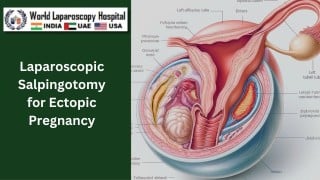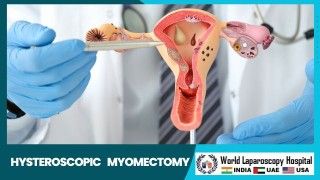Minimally Invasive Marvel: Laparoscopic Surgery for Ovarian Dermoid Cyst
Add to
Share
987 views
Report
2 years ago
Description
In recent years, laparoscopic surgery has emerged as a minimally invasive marvel in the field of gynecological procedures, offering precise treatment with minimal scarring. One such condition that benefits from this groundbreaking approach is the ovarian dermoid cyst, a common benign tumor that can cause discomfort and reproductive health concerns in women. Traditionally, the surgical removal of ovarian dermoid cysts required large abdominal incisions and lengthy recovery periods. However, with the advent of laparoscopic surgery, patients now have access to a more advanced and patient-friendly alternative. Laparoscopic surgery for ovarian dermoid cysts has revolutionized the field by providing numerous benefits, including smaller incisions, reduced post-operative pain, shorter hospital stays, and faster recovery times. The laparoscopic approach involves making a few small incisions in the abdomen, through which a thin, flexible tube called a laparoscope is inserted. Equipped with a high-resolution camera and specialized surgical instruments, the laparoscope allows the surgeon to visualize the cyst and surrounding structures with exceptional clarity. This enhanced visualization enables the surgeon to perform precise and meticulous surgical maneuvers while minimizing damage to healthy tissues. During the procedure, the surgeon gently separates the ovarian dermoid cyst from the surrounding ovarian tissue, taking care to preserve the organ's function and fertility whenever possible. The cyst is then carefully extracted through one of the small incisions. The entire process is guided by real-time imaging, ensuring optimal surgical outcomes. One of the most significant advantages of laparoscopic surgery for ovarian dermoid cysts is the reduced scarring it offers. The small incisions result in minimal visible marks on the abdomen, greatly enhancing the aesthetic outcomes for patients. Moreover, the smaller incisions lead to less tissue trauma, resulting in reduced post-operative pain and discomfort. Patients experience shorter hospital stays and quicker recoveries, allowing them to return to their daily activities and normal routines more swiftly than with traditional open surgery. The precise nature of laparoscopic surgery also contributes to a lower risk of complications. The meticulous dissection and removal of the ovarian dermoid cyst decrease the likelihood of rupture or spillage, which can be a concern during open surgical procedures. By minimizing the chances of cyst contents leaking into the abdominal cavity, laparoscopic surgery helps to prevent potential infections or inflammatory reactions. Furthermore, laparoscopic surgery for ovarian dermoid cysts has demonstrated excellent outcomes in terms of preserving fertility. The ability to precisely remove the cyst while preserving the healthy ovarian tissue increases the chances of maintaining ovarian function and hormonal balance. This is particularly important for women of reproductive age who wish to conceive in the future. In conclusion, laparoscopic surgery for ovarian dermoid cysts represents a significant advancement in gynecological care. This minimally invasive approach offers precise treatment with minimal scarring, reduced post-operative pain, shorter hospital stays, faster recoveries, and improved aesthetic outcomes. By combining cutting-edge technology with skilled surgical expertise, laparoscopic surgery ensures optimal outcomes while prioritizing patient comfort and well-being. As this remarkable technique continues to evolve, more women can benefit from its advantages, allowing them to regain their health and quality of life with greater ease and confidence. Moreover, the benefits of laparoscopic surgery extend beyond the immediate post-operative period. The smaller incisions and reduced tissue trauma result in less blood loss during the procedure. This translates to a lower need for blood transfusions, reducing the risk of associated complications. Additionally, the shorter hospital stays associated with laparoscopic surgery for ovarian dermoid cysts contribute to cost savings and enable patients to resume their daily activities sooner, leading to improved overall quality of life. It is worth noting that the success of laparoscopic surgery for ovarian dermoid cysts heavily relies on the surgeon's expertise and experience in performing these procedures. Therefore, it is crucial for patients to seek treatment at reputable medical centers with skilled surgeons who have a proven track record in laparoscopic gynecological surgery. Patients considering laparoscopic surgery for ovarian dermoid cysts should consult with their healthcare providers to determine their candidacy for the procedure. Factors such as the size and location of the cyst, as well as the patient's overall health and medical history, will be taken into consideration during the evaluation process. In conclusion, laparoscopic surgery has revolutionized the management of ovarian dermoid cysts, offering a minimally invasive alternative to traditional open surgery. With its precise approach, smaller incisions, reduced scarring, and faster recovery times, laparoscopic surgery provides patients with numerous advantages and improved outcomes. This groundbreaking technique represents a significant milestone in gynecological care, empowering women to receive effective treatment for ovarian dermoid cysts while minimizing the physical and emotional impact of surgery. As technology continues to advance and surgical techniques evolve, laparoscopic surgery will undoubtedly continue to pave the way for innovative, patient-centered approaches in the field of gynecology.
Similar Videos






